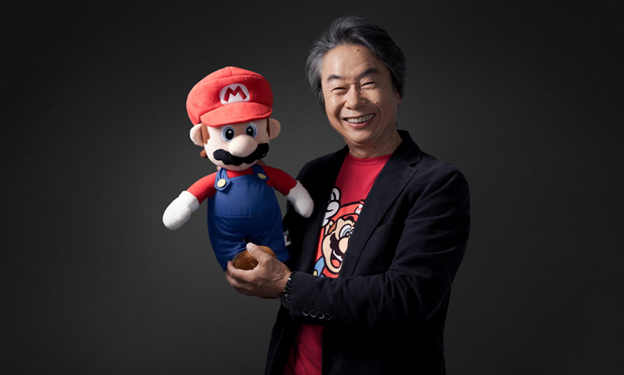The Mushroom Kingdom A Design Guru Built: Learn the secrets behind the success of the “Marvel” behind Mario and Zelda!
| From the desk of Miles Everson: Hello! I hope you are all well and ready to welcome another great week! Let’s kickstart this day by diving into one of our “Marketing Marvels.” Every Monday, we highlight outstanding individuals from whom we can learn interesting and helpful marketing and business insights. Today, let’s talk about one of the most prolific game designers of all time. Continue reading to learn how this “Marvel” became a household name in the world of gaming. |
|
The Mushroom Kingdom A Design Guru Built: Learn the secrets behind the success of the “Marvel” behind Mario and Zelda! Nintendo is one of the biggest video game companies in the world. It has left its mark not only in the world of business but also in pop culture. Spearheading this dominance are “Mario” and “The Legend of Zelda” —intellectual properties (IPs) that have attained critical acclaim and widespread commercial success. While it may sound like an overstatement, these are responsible for reshaping the boundaries of interactive storytelling and gameplay, and have influenced scores of gamers and developers over the past few decades. To understand what made these IPs, and by extension, Nintendo, a household name, we need to take a deep dive on the creative force and mastermind behind them. His name? Shigeru Miyamoto!
Born in Kyoto, Japan on November 16, 1952, Miyamoto is a Japanese video game designer, producer, and game director at Nintendo, where he has served as one of the company’s representative directors since 2002. He is widely known for creating “Mario,” “The Legend of Zelda,” “Donkey Kong,” “Star Fox,” and “Pikmin” —franchises that have sold over 1 billion copies since their creation. Miyamoto graduated with a degree in industrial design and initially wanted to become a professional manga artist. However, in 1977, he was hired as an apprentice at Nintendo, which was still a relatively small Japanese firm that sold playing cards, toys, and games at that time. During his early years in the company, he helped create the art for “Sheriff,” a coin-operated arcade game. Eventually, he was also tapped to help in the creation of “Radar Scope,” a game that saw moderate success in Japan but failed to break into the North American video game market. As a result of this failure, Nintendo was left with unsold units and was on the verge of financial collapse. To mitigate this problem, Nintendo’s then-president, Hiroshi Yamauchi, decided to convert the unsold copies of “Radar Scope” into a new arcade game and tasked Miyamoto to oversee the conversion process. While Miyamoto lacked programming experience, he made up for this by prioritizing player experience, enabling him to create a story, characters, and gameplay mechanics that players found appealing. After spending hours of hard work, this conversion process resulted in the creation of “Donkey Kong,” an arcade game that became a commercial success and served as a crucial factor in Nintendo’s financial turnaround. This success also led Miyamoto to work on sequels that were positively received. Miyamoto went on to create “Mario” and “The Legend of Zelda” —titles that became massive hits due to their captivating game designs.
Throughout his years with Nintendo, Miyamoto became instrumental in helping the company establish a foothold in the gaming industry. To this date, he has worked on lots of titles and was also involved in the development of gaming consoles. So, what were the factors that led to Miyamoto’s success?
— According to Time Magazine, Miyamoto is the “Steven Spielberg” of video games and is also considered as one of the most important game designers of all time. This praise is unsurprising, given that many of his works have pioneered new video game concepts and refined existing ones to a degree no one else had done before. With all of these accolades and praise taken into account, it’s no surprise that Miyamoto became a “Marvel” in his own industry. Since the IPs he’s worked on continue to be popular today, it’s clear that he continues to be a monumental and influential figure in the gaming industry. So, if you want to emulate this level of success, take a deep dive into Miyamoto’s story! You never know, the lessons and insights you can draw from him just might be what you need to take your career or business to the next level. Hope you’ve found this week’s topic interesting and helpful.
Stay tuned for next Monday’s Marketing Marvels! Imagine this: You’re scrolling through your feed, bombarded with content, advertisements, and marketing messages. Suddenly, something catches your eye… Learn more about Ann Handley in next week’s article! |

Miles Everson
CEO of MBO Partners and former Global Advisory and Consulting CEO at PwC, Everson has worked with many of the world's largest and most prominent organizations, specializing in executive management. He helps companies balance growth, reduce risk, maximize return, and excel in strategic business priorities.
He is a sought-after public speaker and contributor and has been a case study for success from Harvard Business School.
Everson is a Certified Public Accountant, a member of the American Institute of Certified Public Accountants and Minnesota Society of Certified Public Accountants. He graduated from St. Cloud State University with a B.S. in Accounting.




